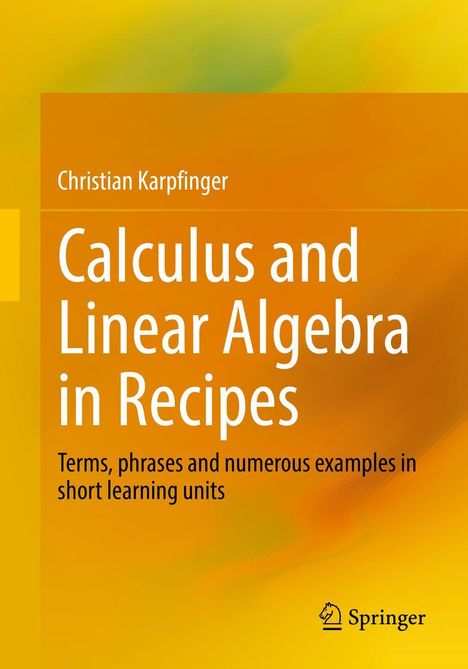Christian Karpfinger: Calculus and Linear Algebra in Recipes, Kartoniert / Broschiert
Calculus and Linear Algebra in Recipes
- Terms, phrases and numerous examples in short learning units
(soweit verfügbar beim Lieferanten)
- Verlag:
- Springer Berlin Heidelberg, 11/2022
- Einband:
- Kartoniert / Broschiert, Paperback
- Sprache:
- Englisch
- ISBN-13:
- 9783662654576
- Artikelnummer:
- 11101986
- Umfang:
- 1064 Seiten
- Nummer der Auflage:
- 22001
- Ausgabe:
- 1st edition 2022
- Gewicht:
- 1742 g
- Maße:
- 240 x 168 mm
- Stärke:
- 57 mm
- Erscheinungstermin:
- 9.11.2022
- Hinweis
-
Achtung: Artikel ist nicht in deutscher Sprache!
Klappentext
This book provides a clear and easy-to-understand introduction to higher mathematics with numerous examples. The author shows how to solve typical problems in a recipe-like manner and divides the material into short, easily digestible learning units. Have you ever cooked a 3-course meal based on a recipe? That generally works quite well, even if you are not a great cook. What does this have to do with mathematics? Well, you can solve a lot of math problems recipe-wise: Need to solve a Riccati's differential equation or the singular value decomposition of a matrix? Look it up in this book, you'll find a recipe for it here. Recipes are available for problems from the · Calculus in one and more variables, · linear algebra, · Vector Analysis, · Theory on differential equations, ordinary and partial, · Theory of integral transformations, · Function theory. Other features of this book include: · The division of Higher Mathematics intoapproximately 100 chapters of roughly equal length. Each chapter covers approximately the material of a 90-minute lecture.· Many tasks, the solutions to which can be found in the accompanying workbook.
· Many problems in higher mathematics can be solved with computers. We always indicate how it works with MATLAB®. For the present 3rd edition, the book has been completely revised and supplemented by a section on the solution of boundary value problems for ordinary differential equations, by the topic of residue estimates for Taylor expansions and by the characteristic method for partial differential equations of the 1st order, as well as by several additional problems.
Biografie
PD Dr. Christian Karpfinger lehrt an der Technischen Universität München; 2004 erhielt er den Landeslehrpreis des Freistaates Bayern.


